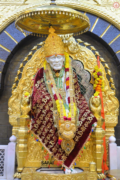By : ‘Seetha’ Priya
What kind of lifestyle would facilitate achieving liberation? Should one progressively withdraw from the external world and its inconsequential activities and live in isolation? Should one contemplate the Divine while being engaged in worldly affairs? Some sages advocate the path of rigorous ascetism, while others believe that one can gain enlightenment even as a householder. A spiritual aspirant is constantly debating – which out of the two is the better option?
 Explaining this subject, Sri Narasimha Swamiji in his Masterpiece ‘The Life of Sai Baba’ quotes an anecdote from Mahabharata. A sage named Jajali stood motionless for many months while practicing extreme ascetism and some birds built their nest and laid eggs in his hair. Overcome by the thought that if he moved, the birds might suffer and die, Jajali remained in that position without food and water till the time the birds grew up and flew away. Jajali rejoiced that by doing so he had reached the pinnacle of ascetism, compassion and spiritual growth.
Explaining this subject, Sri Narasimha Swamiji in his Masterpiece ‘The Life of Sai Baba’ quotes an anecdote from Mahabharata. A sage named Jajali stood motionless for many months while practicing extreme ascetism and some birds built their nest and laid eggs in his hair. Overcome by the thought that if he moved, the birds might suffer and die, Jajali remained in that position without food and water till the time the birds grew up and flew away. Jajali rejoiced that by doing so he had reached the pinnacle of ascetism, compassion and spiritual growth.
Just then a heavenly voice told him that a merchant named Tuladhara was more advanced in spirituality than him and he must visit Tuladhara. When Jajali met Tuladhara he observed that as Tuladhara went about his business of selling goods, different kinds of people came to the shop. Some customers were good, others were bad; some expressed gratitude while others ridiculed the merchant. But Tuladhara remained in perpetual equanimity. He was neither exulted by the love nor distressed by the hatred and went about doing his work honestly. While balancing the scales in his business, Tuladhara had achieved an inner balance that transcends duality.
Sri Narasimha Swamiji concludes that ‘Enlightenment’ is a transcendent state where one realizes that the ‘Self’ is different from body, mind and its sensory objects. Also, pairs of opposites such as pain and pleasure, love and hate, birth and death, attachment and detachment, loss and gain, activity and passivity are nothing but a playful manifestation of consciousness.
The seventh shloka of Vishnu Sahasranama bats for a balanced state of mind in the devotee.
‘Agrahya Shashwatah Krishno Lohitakshah Pratardanah
Prabhutah Strikakubdhama Pavitram Mangalam Param’
Even though Lord Vishnu is ‘Agrahya’ as He cannot be grasped, He is ‘Shashwatah’ – Ever existing. He is ‘Krishna’ the dark-complexioned and bestower of Sat-chid-ananda the balanced state of mind. He is Red Eyed ‘Lohitakshah’ as in Fish incarnation and is ‘Pratardana’ – the destroyer of all our agonies. He is ‘Prabhutah’ – the biggest and existing in three regions as ‘trikakubdhama’ in the lower, middle and upper regions. He is ‘Pavitram’ – the holy and ‘Mangalam Param’ – the beneficent and best.
Consequently, the person remains in a balanced state, at all times and under all circumstances. The individual is full of bliss having experienced the vision of an absolute consciousness in Sai Baba. This ultimately leads to all the emotional, physical and psychological problems that troubled him to dissolve completely.
Sri Narasimha Swamiji got ‘Sai-Sakshatkar’ on 29th August 1936 as he stood in front of Sai Baba’s ‘Samadhi’ at Shirdi after a rigorous itinerant life of eleven years to know the truth. What is important is that the individual contemplates absolute consciousness constantly and uproots whatever it is that creates false illusion in his mind and drives him away from the truth. Whether he is meditating in a remote cave or envisioning the Divine while doing his job in a metropolitan city is just an ancillary event.
One powerful yogic technique that can help a person achieve this difficult task is ‘Pratyahara’, elaborated in the Shandilya Upanishad. Pratyahara is the withdrawal of the senses from their objects. We have experienced this practically in our conversations with Sri Radhakrishna Swamiji at Bengaluru. Whenever someone started discussing politics Swamiji started reciting Vishnu Sahasranama. Here he demonstrated that ‘Pratyahara’ is the withdrawal of the senses and not the external objects per se. Therefore, one can withdraw one’s attachment and attention to external objects anywhere, whether it is a secluded forest or busy shopping mall.
The withdrawal of senses is accomplished when one repeatedly tries to see the one absolute consciousness ‘Sai Baba’ who is hidden in all forms and aspects of creation. With repeated practice, awareness comes up, that all the senses and their umpteen objects, mind and body are a manifestation of absolute consciousness. The mind then gives up craving, it reflects this one consciousness and stays in perfect balance.
Sai Baba states: “I see myself everywhere. There is no place without me. I fill all space in all the directions. There is nothing else but me.” (Sai Satcharitra – Chapter 14, Ovi 48)

Leave a Reply